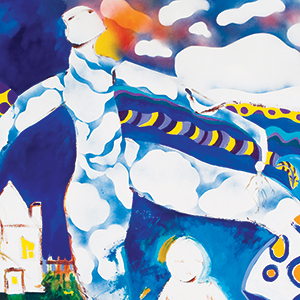Features & Columns
Japantown Art Walk to Help Spotlight New Book on Valley's Art History
through institutional and socio-economic prejudices
 Ruth Tunstall Grant, who painted this work titled 'Protect the Child,' is one of many local artists profiled in Jan Rindfleisch's new book, 'Roots & Offshoots.' Illustration by Ruth Tunstall Grant
Ruth Tunstall Grant, who painted this work titled 'Protect the Child,' is one of many local artists profiled in Jan Rindfleisch's new book, 'Roots & Offshoots.' Illustration by Ruth Tunstall GrantWhen it comes to the interconnected histories of arts activism and community building in Silicon Valley, Jan Rindfleisch is at least one Kevin Bacon degree of separation from every heroic troublemaker for the last 40 years.
No way could she attempt to document everything and everyone, but her new book, Roots & Offshoots: Silicon Valley's Arts Community, goes the distance and draws important parallels from the Ohlone tribes and the San Jose Art League of 1938, straight up to the current day, focusing on a laundry list of individuals, institutions and movements, all of which continue to resonate. This Friday evening, Rindfleisch will sign copies of the book at Roy's Station in Japantown, San Jose's best Buddhist reincarnation of a gas station, a coffee shop also serving as the groovy central nexus for the Japantown Art Walk.
In refreshing fashion, Roots & Offshoots focuses on marginalized people that broke through institutional and socio-economic prejudices, artists that challenged establishment assumptions, or outsiders trying to circumvent the vanilla-male-centric status quo, going back to the mid-20th century. Academic outcasts are given just as much space as individual outcasts, all for the purpose of establishing context in terms of how the disruptive energy of Silicon Valley intertwined with the region's arts history.
The book's attitude is established from the beginning, where seemingly a thousand different threads are crammed into the opening essay alone, including chauvinist fanny pinching in the San Jose State University Art Department elevator circa the late-'70s set against the context of women artists fighting the establishment to be taken seriously. This introductory overview also explores the ways in which ethnic art movements and political artists also spent decades trying to fight the apparatus of exclusion, often only acknowledged in academic or museum shows for token purposes. Much ink is also given to the disruptive ways in which the initial tech microcultures of Silicon Valley shared attitudes with their respective arts startups.
From there, Rindfleisch embroiders the last several decades, weaving various threads of history, often apexing with specific artists who stood out in terms of sheer outsider ambition, creativity and dedication to their causes. People like Ruth Tunstall Grant, Tony May, Consuelo Jimenez Underwood and the Burciagas of Stanford are given their own chapters.
Rounding out the extensive volume, we find MACLA cofounder Maribel Alvarez with an updated version of her mid-1990s essay on the history of that organization. After which Raj Jayadev from Silicon Valley De-Bug explains the approaches behind his respective efforts.
On multiple levels, Roy's Station and the Japantown Art Walk should be a perfect place for a Roots & Offshoots book signing. For one, Roy's functions as the central jumping-off point for the art walk, which invites anyone to prowl around the neighborhood to places like Cukui, Arsenal, Empire Seven Studios, Santo Market and Petite Galleria, along with several other local establishments.
The patio outside Roy's will feature numerous musicians and creative types all crammed into the same space. Several artists mentioned in Roots & Offshoots will appear, including San Jose Taiko founders Roy and PJ Hirabayashi, who will lead a special 8pm performance. As part of their gig, everyone will be invited to join in a flashmob-style dance of "Ei Ja Nai Ka." Written by PJ, "Ei Ja Nai Ka" has been taught and performed around the world to celebrate compassion and peace.
A key essay in Roots & Offshoots covers Roy and PJ, along with legendary cartoonist Jack Matsuoka, who lived in Japantown during his final years. San Jose Taiko began as a bottom-up grassroots effort. It was non-hierarchical and non-gender-specific. From the beginning, women were bashing on drums alongside the guys. In Matsuoka's case, he was among those relocated to the internment camps during World War II and later spent decades educating the public about the atrocities via his cartoons. His work in a variety of subject matters helped drive a resurgence in Japanese-American culture during the last few decades of his life. San Jose was grateful to have him.
So with Rindfleisch's book as the macrocosm, the Japantown Art Walk will function as the microcosm just for one night. Of course, Roy's Station will be the current-life Japantown social headquarters for all that came before and all that is yet to come.
Japantown Art Walk
Friday, Sept. 8
5-8pm
Roy's Station Coffee & Teas
197 Jackson St, San Jose
Free


